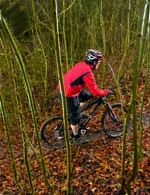 FRAME
FRAME
All of the tube profiles here are seriously manipulated. The down tube is bi-axially ovalised to marry better with the head tube and bottom bracket shell, and the top tube is squashed to narrow its profile. Sandwiching the top tube is the rocker link pivot mount and seat tube gusset. A forward facing slot in the seat tube helps keep dirt out of the frame. CNC-machined magnesium rocker plates are lighter and stiffer than aluminium, and a carbon bridge is bonded into them for stiffness.
All pivots use cartridge bearings and the two pivots on the front triangle use 12mm hollow bolts. We’d also like to see integrated dust covers on all of the pivot hardware to improve sealing. In all, frame quality on the Epiphany is excellent.
SUSPENSION
ICT Instant Centre Tracking is Tony Ellsworth’s take on a true four-bar suspension design. Long, flat link plates project the Instant Centre (or virtual pivot) well in front of the fork and, because the pivot position migrates as the suspension compresses, Ellsworth can fine-tune the axle path to minimise chain growth and the negative effects of pedal feedback. The Fox RP23 shock has been inverted so that you can get to the Schrader valve to inflate the shock. This does not affect the performance of the shock whatsoever but it does mean that you really have to reach for the ProPedal lever.
SIZING
When the Ellsworth turned up everyone who sat on it commented on how long it was. But when we got the tape measure and angle finder out we discovered that the front end (not the top tube) was shorter than the Orange and only marginally longer than the Cove. The slack seat angle and 20mm layback on the RaceFace seatpost were placing the saddle too far back. We shoved the saddle as far forward as the rails would allow and when we measured from the nose of the saddle to the stem centre it was in keeping with the other bikes. So, if you are thinking of building up an Epiphany we suggest buying an inline seatpost.
PERFORMANCE
With the steepest head angle on test we were pretty certain that the Epiphany was going to be the best traditional XC full-suspension bike here. But when we took it on our muddy XC test loop we really had to fight the front wheel as it had a tendency to tuck under at the slightest loss of traction. This is where the extra width of the Race Face bars really came into play. In terms of suspension performance the Ellsworth sits squarely between the Orange and the Cove, offering a good balance of comfort and efficiency. But the Ellsworth’s trump card is that your pedal stroke is never interrupted by the action of the suspension. Out of the saddle climbing in the middle ring does cause the suspension to extend slightly so it’s not strictly true that the suspension is completely independent. We also found that the bike squats more than the Turner or Cove when climbing seated in the middle ring. On the descents the Epiphany was surprisingly surefooted but the frame has more flex than the other bikes here.
VERDICT
If you are a weight weenie the Epiphany should be at the top of your list of possible trail bikes. But if you want to save weight on your bike because you’re carrying a few extra pounds yourself we recommend looking elsewhere; the Epiphany just isn’t stiff enough for big-boned riders. That said, if you are of slight build or are a particularly smooth rider then the Epiphany is a great bike that can be ridden harder than its weight or geometry suggests.
MBR RATING: 8/10



